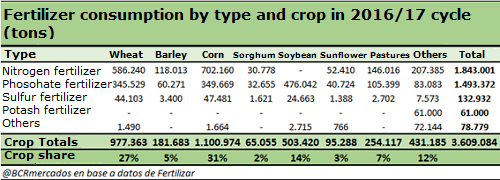Argentine fertilizer consumption today is 12 times higher than in 1990.
BLAS ROZADILLA - JULIO CALZADA
Fertilizers consumption last year was 3.77 million tons, more than two times the consumption levels reported 17 years ago, in 2000. In 2017, the consumption of fertilizers in Argentina showed a year-on-year increase of 4.4%, reaching 3.77 million tons. This number set a national record, exceeding the 3.72 million tons consumed in 2011. Twenty-seven years ago, in 1990, Argentine farmers consumed only 300 thousand tons. Therefore, fertilizer utilization grew by 1,156% during this period, in other words, its consumption multiplied by 12 in less than 30 years.
As the graph shows, there has been a sustained growth of fertilizers of national origin use due to the increase in production, from the beginning of the century. After Argentina's 2001 economic and political crisis, national fertilizers went from representing less than 10% of the market to over 30%, reaching their maximum share of 48.5% in 2015. In 2017, the local production of fertilizers was 1,942,400 tons, the highest record in the last 6 years. The same can be said of exports, which rose to 4.8 million tons. Last year in Argentina, 52.8% of the fertilizers used were nitrogenous (whose demand is satisfied mainly by local production) and 38.6% phosphates (mostly imported). Total fertilizer consumption in 2017 was 3.77 million tons. Nitrogen fertilizers represented 52.8% (1.99 million tons), phosphate fertilizers 38.6% (1, 45 million), sulfur fertilizers 4.3% (162 thousand tons), potash fertilizers 1.8% (66.5 thousand tons) and other types 2.6%. In Argentina, local production of nitrogen fertilizers meets local demand, while most phosphates are imported.
Wheat and corn are the main drivers of fertilizer consumption in Argentina. These two crops' fertilizers requirements are 58% of the country's total consumption. As for soybean, it only absorbs 14% of the national total. Soybean, corn and wheat are the largest-planted-area crops in Argentina. Their fertilizers consumption combined is 70% of the national total, although there are great differences between each crop's uses. Corn and wheat, on the one hand, consume 58% of the total, as soybean, on the other hand, consumes only 14%. Moreover, soybean share is only reached thanks to the great size of its planted area (20 million hectares) that doubles corn and wheat croplands combined. That is, soybean does not require intensive fertilizer use. In the first four months of 2018, fertilizer consumption grew by 6.3% year-on-year. There has been an important rise in nitrogen fertilizers consumption of 12.8%, while phosphates fell by 7.2%. This is strongly related to the drought that affected soybean this summer in Argentina.

